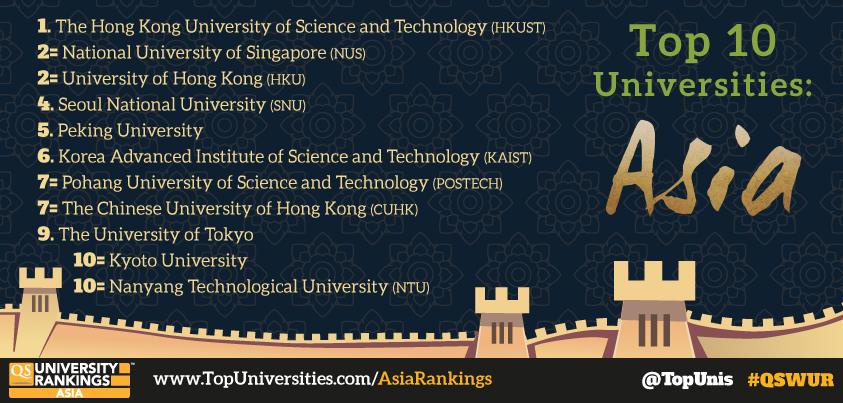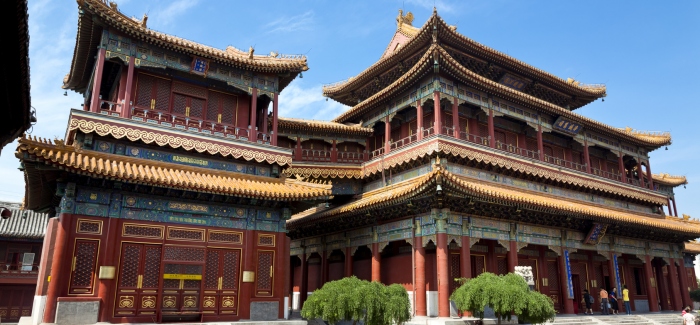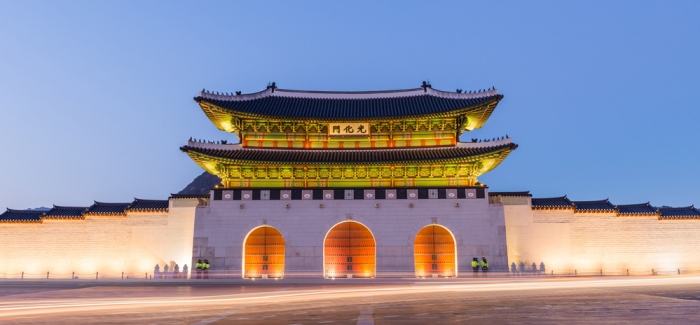The article below is based on the 2013 results. To view the latest version of this article based on the QS University Rankings: Asia 2015, click here.
Take a closer look at this year’s top 10 universities in Asia, including three Hong Kong universities, three South Korean, two Singaporean, two Japanese and one from mainland China. (That’s actually 11, as tenth place is shared).
1. The Hong Kong University of Science and Technology (HKUST)
HKUST retains the number one spot it has held since 2011, a particularly impressive feat considering it was established only a little more than two decades ago. HKUST also heads the Top 50 Under 50, QS’s ranking of the world’s best universities under 50 years old. Strong government funding has clearly helped HKUST to maintain its strong performance across all indicators, even during transition from a three-year to a four-year degree model.
2= National University of Singapore (NUS)
Singapore’s flagship university comes top in the employer reputation survey and second in the academic reputation survey. Its strongest rating from academics is in the field of social sciences and management. NUS also has the second highest score for research citations, behind Tokyo Medical and Dental University.
2= University of Hong Kong (HKU)
Having topped the Asia ranking in its first two years (2009 and 2010), HKU had fallen to third, but reclaims one position this year. HKU comes fifth in the academic reputation survey overall, with its strongest faculty areas being social sciences (rated 3rd in the region), life sciences & medicine (4th) and arts & humanities (5th).
4. Seoul National University
Also maintaining the same position this year, Korea’s leading university has been slowly climbing since the inaugural 2009 ranking, when it was 8th. Seoul National University comes sixth in the academic reputation survey, and tenth in the employer reputation survey. Overall it’s a good year for Korea – the top seven Korean universities have all either maintained or improved their positions this year.
5. Peking University
Reputation is clearly the strong point of China’s highest entry, which climbs one place this year. Peking University comes third in both the academic and employer reputation surveys, but is outside the top 10 on all the other indicators used. Its strongest academic ratings are for arts & humanities and natural sciences.
6. Korea Advanced Institute of Science and Technology (KAIST)
KAIST also climbs one position this year, part of the ongoing success story for Korean universities. Established in 1971, KAIST comes fourth in this year’s Top 50 Under 50, and climbed to 63rd in the last QS World University Rankings. Reflecting its focus on science and technology, it gets its highest academic reputation ratings for engineering & technology (rated 6th in the region) and natural sciences (11th).
7= Pohang University of Science and Technology (POSTECH)
KAIST’s fellow Korean science and tech-focused institution is close behind, climbing two places this year. It gets particularly strong scores for faculty-student ratio (3rd in the region) and research citations per paper (4th). But while comfortably ahead of KAIST on these indicators, POSTECH lags behind in the reputation surveys – 34th in the academic survey and 40th in the employer one, compared to KAIST’s 14th and 24th.
7= The Chinese University of Hong Kong (CUHK)
CUHK falls two places this year, continuing its gradual loss of position since 2009’s inaugural QS University Rankings: Asia, when it ranked second. Its reputation appears to be considerably stronger among academic than employers – it comes 9th in the academic survey, and 22nd in the employer survey. Its strongest academic ratings are for arts & humanities and social sciences & management.
9. University of Tokyo
Down one place this year, the University of Tokyo has lost significant ground since the first Asian ranking, which it entered in third place. However, it retains an extremely strong reputation among Asian academics – it tops the academic reputation survey overall, and is rated the region’s number one in four out of the five faculty areas, coming second in social sciences behind NUS.
10= Kyoto University
Holding the same position as last year, Japan’s second top-10 entry also does very well in the academic reputation survey, where it comes fourth. Rather neatly, Kyoto University is rated 2nd for natural sciences, 3rd for life sciences & medicine, 4th for arts & humanities, 5th for engineering & technology, and 6th for social sciences & management.
10= Nanyang Technological University (NTU)
This is an impressive climb for Singapore’s second ranked university, which was 17th last year. Like HKUST, NTU is just 22 years old. Having climbed to 47th in the last QS World University Rankings, it comes second in this year’s Top 50 Under 50. It comes 6th in the employer reputation survey, 13th in the academic reputation survey, and is the region’s number one in the indicator for international diversity of staff.








